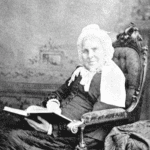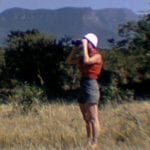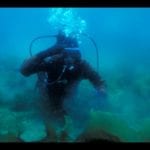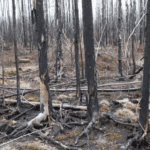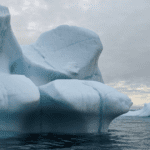Upon stepping into the Museum of Nature’s brightly lit rotunda, the words Courage and Passion are impossible to miss. “We kept on coming back to those words over and over again, especially when we were talking about women trailblazers, but also when we started looking at challenges that girls face,” said Dr. Cindy Stelmackowich, the exhibit curator and women and gender studies professor at Carleton University.
The Courage and Passion: Canadian Women in Natural Sciences exhibit at the Museum of Nature in Ottawa celebrates the work of trailblazing Canadian female scientists. Keeping a family-oriented audience in mind, the exhibit strives to inspire and educate girls about careers in STEM (science, technology, engineering, and math) and raises awareness for the many challenges that women in the natural sciences can face.
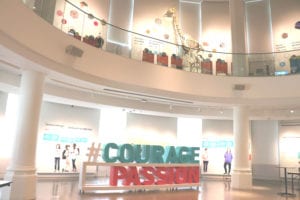
(Photo | Cindy Stelmackowich)
Upon entering, visitors are immediately greeted by pictures of three Ottawa-based girls in grade school, high school, and university, all interested in pursuing careers in the natural sciences. The three guides appear throughout the exhibit to provide a relatable perspective.
The rest of the lower floor continues to introduce visitors to the many challenges faced by women in STEM such as a lack of role models, social discouragement, or exclusive work environments. “It starts at a very, very young age that girls are dissuaded not to pursue their interest in science,” said Stelmackowich. “We have to address all this in the exhibit, but also make it palatable for young girls to say ‘Hey, what is science? I should remain interested, and why?’”
The exhibit, launched in July, celebrates 100 years since women won the right to vote in federal elections—a decision that was actually passed in the exact same room where the gallery is now held. The museum’s rotunda hosted the House of Commons for four years after the Centre Block of Parliament was destroyed by a fire in 1916. “It has this wonderful historical continuity,” said Stelmackowich.
A leaky pipeline
The exhibit demonstrates a “leaky pipeline” problem in which women are more likely to turn away from STEM throughout various stages of their careers for a variety of reasons. During the formative years, girls may have budding interests in the sciences nipped by stereotypes perpetuated by narratives told by the likes of “math is hard” Barbie. At the high school level, pursuing STEM can be socially stigmatized, and at the university and professional levels, women can be turned away by exclusive work environments and gender biases.
Stelmackowich gave the example of a female researcher she spoke to that submitted a paper for publishing and was told by the journal that publication would be more likely if her study included at least one male co-author. And in 2015, Nobel winning biochemist Tim Hunt remarked that “girls” are a problem in science because “You fall in love with them, they fall in love with you, and when you criticise them they cry.” (although Hunt’s actual sentiment behind the statement remain unclear).
According to Statistics Canada, in 2015 women only made up 22% of the STEM workforce, only a 2% increase in the last 28 years. In addition, women are on average still paid 7.5% less than their male counterparts in STEM.
Researchers propose that having role models is one of the key methods of patching up the leaky pipeline. The upper level of the Courage and Passion exhibit does just that—museum curators have gathered artefacts, historical documents, and specimens to tell the stories of 20 ground-breaking Canadian women researchers.
Trailblazers
The upstairs exhibit begins with Canada’s early naturalists. Prior to the twentieth century, women were barred from professional careers in the sciences, but recreational plant collecting was deemed a suitable pastime for women. Catherine Jérémie (1664–1744), Lady Dalhousie (1786–1839), and Catharine Parr Traill (1802–1899) were some of Canada’s first naturalists.
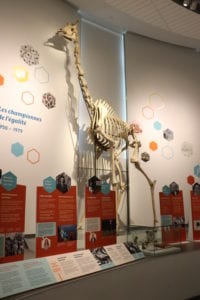
(Photo | Cindy Stelmackowich)
The next section highlights Canada’s first working professionals. Here you’ll find Harriet Brooks (1876–1933), Canada’s first female nuclear physicist. Her promising career was cut short at the young age of 31 because, at the time, marriage had the power to force women into retirement.
“One of the things I was noticing with all of these women is that they didn’t have children—they were never married,” said Stelmackowich. Stelmackowich found this peculiar and did some research: “Sure enough, I found this marriage ban, which in 1920 came out of the Privy Council office.” The marriage ban, effective from 1920 until 1950s, effectively barred married women from working full-time with the federal services.
Professional opportunities improved for women after the Second World War but were still limited. Alice Wilson (1881–1964) was the first female geologist with the Geological Survey of Canada and Fellow of the Royal Society of Canada, but she was still banned from doing field research.
Nearby Wilson’s tribute stands a 16-foot tall giraffe specimen representing zoologist Anne Innis Dagg (1933) who travelled to South Africa to study giraffes in the wild. Innis Dagg had to hide her female identity while traveling by shortening her signature to A. Innis.
The final section of the exhibit celebrates many contemporary female researchers. Victoria Kaspi was the first woman astrophysicst to receive the prestigious Herzberg medal, Gwen Bridge is a member of the Saddle Lake Cree Nation and a forest hydrologist, and Antarctic marine biologist Kathy Conlan was named one of Canada’s greatest explorers by Canadian Geographic.
Stelmackowich said that one the most rewarding parts of the exhibit is introducing visitors to the Canada’s incredible women trailblazers and educating young families about the challenges girls in STEM can face. Across the board, the leaky pipeline problem can be mitigated by presenting role models, raising awareness for the barriers to success, and inspiring girls with the many career opportunities in STEM.
The Courage and Passion: Canadian Women in Natural Sciences exhibit will be available until March 31, 2019 at the Canadian Museum of Nature.
- Catharine Parr Traill was a writer and one of Canada’s first naturalists.
- Harriet Brooks was Canada’s first female nuclear physicist who was forced into retirement because she got married.
- Anne Innis Dagg who traveled to South Africa to study giraffes in the wild. (Photo | Museum of Nature)
- Kathy Conlan is an Antarctic marine explorer. (Photo | Museum of Nature)


